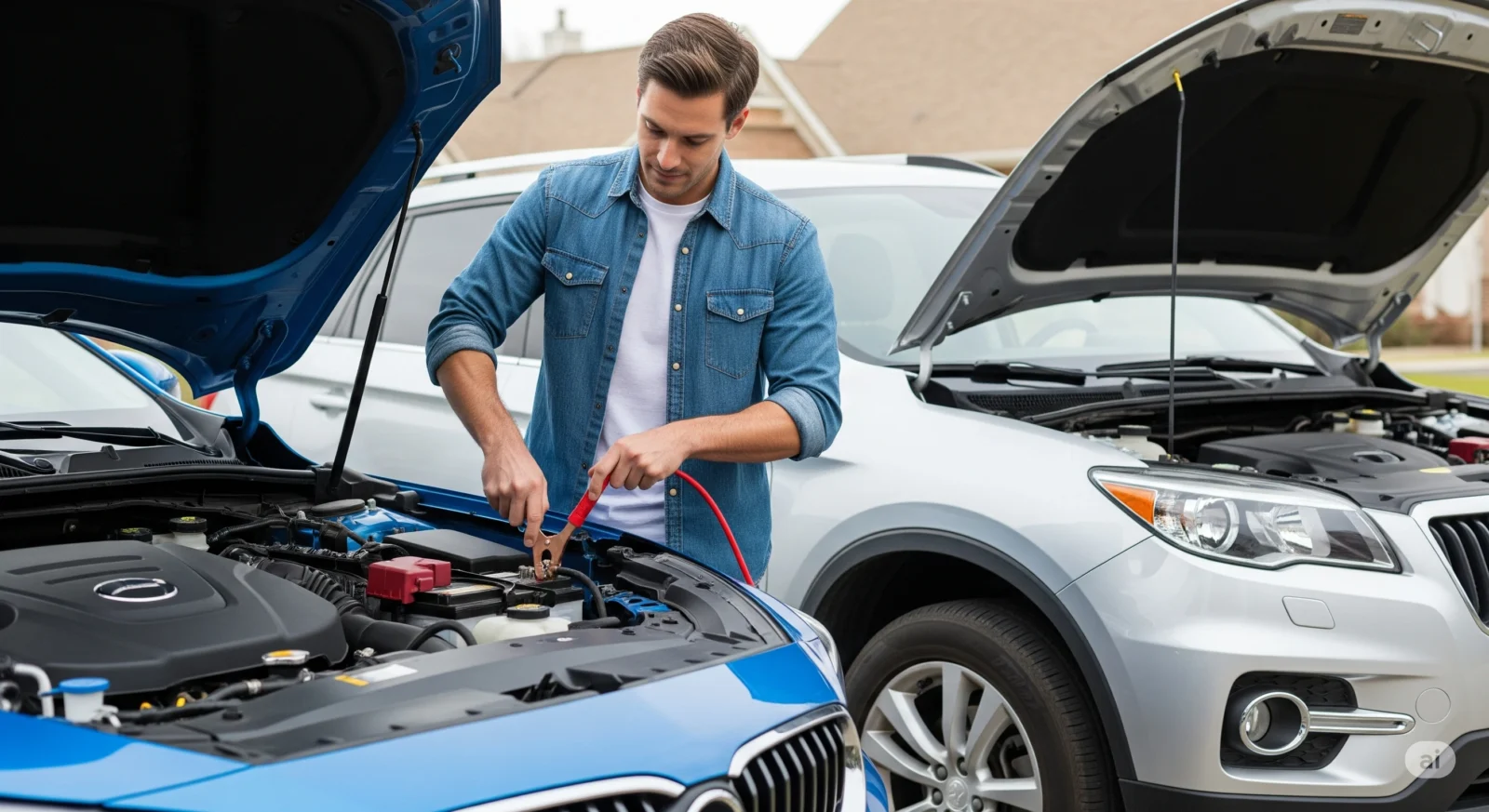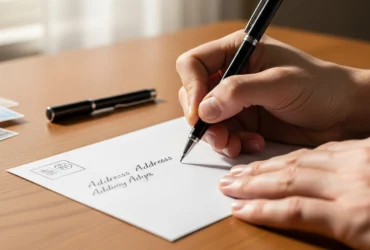That sinking feeling. You turn the key, and instead of a powerful roar, you hear a sad “click, click, click”—or even worse, total silence. A dead car battery can ruin your day, but it doesn’t have to. Learning how to jumpstart a car is a basic skill every driver should have. It’s simpler than you think, and with this guide, you can get back on the road safely and confidently. We’ll walk you through the entire process of how to jumpstart a car so you feel prepared for anything.
“The difference between a major problem and a minor inconvenience is knowing what to do. A pair of jumper cables and a little knowledge can turn a day-ruining event into a quick fix.”
Why Knowing How to Jumpstart a Car Is a Lifesaving Skill
I’ll never forget the first time my battery died. I was a brand new driver, stranded in an empty parking lot after a late movie. My phone was dying, and I felt completely helpless because I didn’t know the first thing about how to jump-start a car. A kind stranger helped me out that night, and I made a promise to myself: I would never feel that clueless again. Now, with over 15 years of hands-on experience, I want to share the proper way how to jumpstart your car. This guide is the friendly, calm voice I wish I had on that dark night.
What You’ll Need to Jumpstart Your Car
Before you begin, you must gather two essential items. Having these in your trunk is the first step in being prepared to jumpstart a car whenever you need to.
- A set of Jumper Cables: Make sure they are in good condition, without any frayed wires or broken clamps.
- A Second Car (the “donor” car): This car must have a working battery that is the same voltage as yours (most cars use a 12-volt battery).
How to Jumpstart a Car Safely: 8 Simple Steps
Follow these steps in order. Safety is the most important part of this process, so don’t rush as you learn how to jumpstart a car safely.
- Position the Cars Correctly. Park the working car (the donor car) so it’s facing your car, or next to it. The cars should be close enough for the jumper cables to reach both batteries comfortably, but they must not touch each other.
- Turn Everything Off and Put Cars in Park. Turn off the ignition, lights, radio, and air conditioning in both cars. Engage the parking brake on both vehicles. This is a critical safety check for this procedure.
- Open the Hoods and Identify the Batteries. Locate the battery in each car. You’re looking for two metal posts, called terminals. They will be marked with a PLUS (+) sign (positive) and a MINUS (-) sign (negative). The positive terminal often has a red plastic cover.
- Insight: If the terminals are dirty or corroded (covered in a white or greenish powder), wipe them clean. A good connection is essential if you want to successfully jumpstart a car (7).
- Connect the RED (Positive) Cable.
- Take the red (positive) jumper cable.
- Attach one red clamp to the POSITIVE (+) terminal of the DEAD battery (your car).
- Attach the other red clamp to the POSITIVE (+) terminal of the WORKING battery (the donor car).
- Connect the BLACK (Negative) Cable.
- Take the black (negative) jumper cable.
- Attach one black clamp to the NEGATIVE (-) terminal of the WORKING battery.
- IMPORTANT: Attach the LAST black clamp to an unpainted metal surface on the DEAD car’s engine block. A bolt or a bracket on the engine is perfect. Do NOT connect it to the negative terminal of the dead battery.
- Why? This is the safest way how to jumpstart a car. Connecting to the dead battery directly can create a spark, which could ignite hydrogen gas. Grounding it to the engine block prevents this.
- Start the Working Car. Start the engine of the donor car and let it run for 2-3 minutes. This sends a charge to the dead battery.
- Try to Start Your Car. Now, try to start your car. If it starts, great! You’ve successfully completed the most important part. If it doesn’t, wait another couple of minutes and try again. If it still won’t start after a few tries, your attempt to jumpstart the car may have failed due to another issue.
- Remove the Cables in REVERSE Order. Once your car is running, carefully remove the jumper cables in the exact reverse order you attached them. This finalizes the process of how to jumpstart a car.
- Remove the black clamp from the engine block of your car.
- Remove the black clamp from the donor car’s battery.
- Remove the red clamp from the donor car’s battery.
- Remove the red clamp from your car’s battery.
Congratulations! You’ve just learned how to jumpstart your car. Be sure to drive your car for at least 15-20 minutes to allow the alternator to fully recharge your battery.
7 Pro Tips for How to Jumpstart a Car Safely
- Read Your Owner’s Manual: Some modern cars have specific jump-starting procedures. A quick check is a great idea before you jumpstart a car.
- Wear Safety Glasses: It’s rare, but batteries can be unpredictable. Protect your eyes.
- Never Let the Clamps Touch: This can cause dangerous sparks and damage electronics.
- Work in a Ventilated Area: Never try this in a closed garage.
- Check the Cables First: Good quality cables make all the difference.
- Don’t Jump a Frozen Battery: If you suspect the battery is frozen, do not attempt it. It could explode.
- Keep Revs Steady: Gently revving the donor car’s engine can send a stronger charge.
3 Common Mistakes to Avoid When Jump-Starting
- Mixing Up the Cables: This is the most dangerous mistake. It can fry both cars’ electronics. Red on Plus (+), Black on Minus (-).
- Connecting the Last Clamp to the Dead Battery: This creates a spark right where flammable gases might be. Always ground it.
- Shutting Off Your Car Too Soon: After a successful jump, drive for at least 15-20 minutes. If you shut it off right away, you’ll probably need to figure out how to jumpstart a car all over again.
How to Jumpstart a Car Without Another Car
You don’t always need a second vehicle. A portable jump starter is an amazing tool that shows you how to jumpstart a car without another car. These are small, powerful battery packs that are safer and easier to use than cables—just connect the pack’s clamps to your battery and turn it on.
Troubleshooting: What If It Still Won’t Start?
If you followed all the steps and your car still won’t turn over, here are a few possible reasons:
- The Battery is Completely Dead: It may be too old or damaged to hold a charge and will need to be replaced.
- Poor Connection: Double-check that all four clamps are making solid contact with clean metal. A bad connection is a common reason a jumpstart fails.
- A Different Problem: The issue might not be the battery. It could be a bad starter or alternator. In this case, it’s time to call for roadside assistance.
Conclusion
A dead battery is a nuisance, but now you have the power to handle it. By following these simple steps, you can safely jumpstart a car and turn a stressful situation into a manageable task. Keep this guide handy, store a set of jumper cables in your trunk, and drive with the peace of mind that comes from knowing how to jumpstart a car. If you found this guide helpful and want to find more clear, simple answers for other “how-to” queries, be sure to visit howtoresults.
FAQs
Can you jumpstart a car in the rain?
It’s not ideal, but you can. Take extra care to keep the clamps and batteries as dry as possible to prevent a short circuit.
How long does it take to jumpstart a car?
The process itself takes about 5-10 minutes. However, you should drive for at least 15-20 minutes afterward to let the alternator recharge the battery.
What happens if you connect jumper cables the wrong way?
This is extremely dangerous. It can damage the battery and fry the sensitive electronic components in both cars, leading to very expensive repairs.
Can you jumpstart a car without another car?
Yes. The best alternate method is using a portable jump starter pack.
Do both cars need to be off when connecting jumper cables?
Yes. Ensure both cars are completely off before you begin connecting cables. This is a key safety rule for anyone learning how to jump-start a car.
Can a smaller car jumpstart a bigger car (like a truck)?
Sometimes, but it’s difficult as the smaller car may not provide enough power. It’s best to use a vehicle with a similar or larger battery.
Why do you connect the black cable to a metal ground instead of the battery?
This is a vital safety step to prevent sparks from occurring directly over the battery, which can release flammable gas.
Will jump-starting damage my car?
If done correctly by following the right procedure, it is perfectly safe. Damage occurs when steps are missed or cables are connected incorrectly.
How do I know if it’s the battery or the alternator?
If the car starts but dies again immediately after disconnecting, it’s likely a bad alternator. If it runs fine but won’t start again later, it’s probably an old battery.
Do you need to rev the engine when jump-starting?
Gently revving the donor car’s engine to around 2,000 RPM for a minute can help charge the dead battery faster before you try to start it.














Leave a Reply